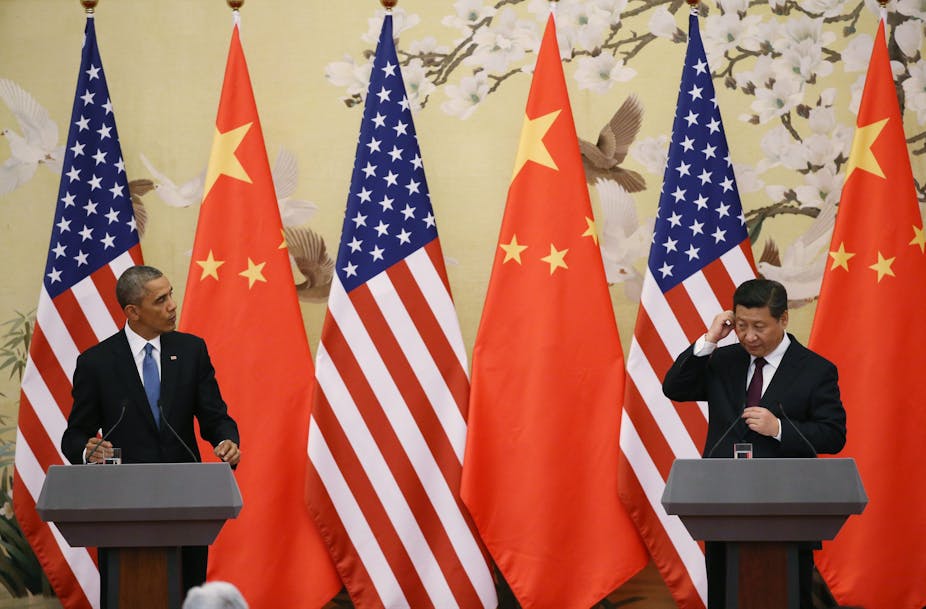The new US-China climate deal is a game-changer.
The United States, the world’s biggest historical emitter of greenhouse gases, has pledged to cut emissions by 26-28% by 2025 relative to 2005 levels, while China, the current biggest emitter, has promised to peak its emissions by no later than 2030.
The agreement between the world’s two biggest greenhouse gas emitters is part of preparations for the United Nations negotiations in Paris next year, where the rest of the world will attempt to hammer out a meaningful deal to limit emissions.
It is a significant step forward. Back in 2009, the keenly anticipated UN climate conference in Copenhagen failed, largely because of a standoff between the two states.
Their inability to collaborate and to reach a level of mutual recognition of each other’s capacities and limits before the conference was a major contributor to the meeting’s chaotic close and weak, non-binding outcome.
The big turnaround
This time, things seem different. Both states have recognised their responsibility to show leadership on the climate issue.
China’s pledge to peak its emissions by 2030 indicates that it is now willing to assume a leadership role in international climate negotiations – a role commensurate with its global economic importance, with its status as the world’s largest greenhouse gas emitter, and as a country that would be devastated by accelerating climate change.
China’s proposed target – the first time it has agreed to stop growing its emissions in absolute terms – points to a willingness to shift towards a post-carbon economy.
It is also a pragmatic response to the social and political challenges posed by dangerous levels of domestic air pollution, caused in part by dirty industrialisation and the use of fossil fuels, in its major cities.

Meanwhile, US President Barack Obama’s pledge effectively throws down the gauntlet to the newly Republican-controlled Congress.
The US Climate Action Plan has been Obama’s main policy for meeting the previous target of 17% below 2005 levels by 2020, which he announced at Copenhagen.
But Obama has been unable to legislate to establish a national emissions trading scheme in support of the existing US target or of tougher goals.
Nevertheless, even in the absence of such a scheme, US emissions have dropped significantly because of the global financial crisis and its economic aftermath in the United States, the development and uptake of new gas sources, and the use of existing regulatory measures.
In 2012, US emissions were 10% below 2005 levels and the United States seems likely to achieve its 2020 target, despite the recent upswing following several years of emissions decline.
The new US target of 26-28% below 2005 by 2025 increases the pressure the country is putting on itself to perform and reform. The joint announcement also forces Congress to recognise that China believes that its economic competitiveness – and its challenge to the United States’ economic dominance – will not be harmed even by rapid decarbonisation.
This knowledge should reinforce Obama’s push for better and more aggressive emissions-reduction measures, enshrined in domestic law, that will also help to modernise the American economy.
But is it all enough?
That’s the good news. Now for the not-so-good news.
These commitments will frame the levels of ambition required of other states at Paris next year. Climate modellers will no doubt now be rushing to determine what these new commitments, if delivered successfully, will mean for combating global warming.
The US and Chinese cuts, significant though they are, will not be enough to limit the total increase in the atmospheric carbon dioxide unless other states engage in truly radical reductions.
In other words, global emissions are likely to continue to grow, probably until 2030, which will make it impossible to hold global warming below the world’s agreed limit of 2C above pre-industrial levels.
Australia snookered
Nevertheless, this announcement means that laggard states like Australia can no longer hide behind the fiction that major developing economies like China are unprepared to make serious efforts to cut their emissions.
It further embarrasses Australia in its attempt to keep climate change off the agenda at the meeting of the G20 next week.
It increases the pressure on Australia to bring substantial target commitments to the table in Paris in 2015 – something the Abbott government is presently resisting vigorously.
And it strongly suggests that the Abbott government’s longed-for coal export boom will, as many have predicted, turn out to be an illusion.

